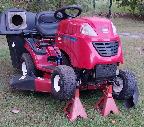*** Restricting New Posts to SD Premium Members ONLY *** (09 May 2025)
Just made a new account? Can't post? Click above.
Siennna 2000 high fuel trims error p0171
- seraj2000
-
Topic Author
- Offline
- New Member
-

- Posts: 16
- Thank you received: 0
error p0171 system lean
getting high LTFT on idle 25% both banks. ltft1 and ltft2
changed fuel injectors. no change
did vacuum test. no leaks after changing gasket at plenum
new maf sensor. no changes
did fuel pressure test. key on I am getting 0 pressure reading
engine on I get 50 psi. engine off holds fuel pressure.
car runs fine and has no problem starting or idling.
What could be causing lean condition? Thx!
Please Log in or Create an account to join the conversation.
- Hardtopdr2
-
- Offline
- Platinum Member
-

- Posts: 849
- Thank you received: 148
Check hoses, brake booster, intake air tube from filter housing to intake for holes tears, egr assembly, etc. Smoke test it and you should find it. I squirt water on intake plenum while engine running you will hear it get sucked in.
Please Log in or Create an account to join the conversation.
- seraj2000
-
Topic Author
- Offline
- New Member
-

- Posts: 16
- Thank you received: 0
Please Log in or Create an account to join the conversation.
- Cheryl
-
- Offline
- Platinum Member
-

- Posts: 1214
- Thank you received: 215
Please Log in or Create an account to join the conversation.
- seraj2000
-
Topic Author
- Offline
- New Member
-

- Posts: 16
- Thank you received: 0
on foxwell it reads 3.28 on b1s1 and same on b2s2 at idle
can you explain what readings you are looking for? I can do tests and post back. Thx
Please Log in or Create an account to join the conversation.
- Cheryl
-
- Offline
- Platinum Member
-

- Posts: 1214
- Thank you received: 215
Please Log in or Create an account to join the conversation.
- seraj2000
-
Topic Author
- Offline
- New Member
-

- Posts: 16
- Thank you received: 0
Please Log in or Create an account to join the conversation.
- John Curtis
-
- Offline
- Platinum Member
-

- Posts: 344
- Thank you received: 111
What does freeze frame show?
What is afr values during throttle snap?
Making Pressure Differential Sensors (PDA Sensors) for pressure pulse diagnostics.
Currently servicing Central Texas.
Please Log in or Create an account to join the conversation.
- juergen.scholl
-

- Offline
- Platinum Member
-

- Active partschanger
- Posts: 1230
- Thank you received: 462
The data and description you provided suggests that the computer is (still) in fuel control.....
If not done already you might want to check fuel volume, apart from pressure. Did you check alcohol content of the fuel?
An expert is someone who knows each time more on each time less, until he finally knows absolutely everything about absolutely nothing.
Please Log in or Create an account to join the conversation.
- seraj2000
-
Topic Author
- Offline
- New Member
-

- Posts: 16
- Thank you received: 0
I just replaced the B1S1 to genuine Denso 234-9007
no difference. and seems like ltft jumped to almost 40%
I'll post some graphs soon on both sensors.
how do I test fuel quality? and videos or links?
Please Log in or Create an account to join the conversation.
- juergen.scholl
-

- Offline
- Platinum Member
-

- Active partschanger
- Posts: 1230
- Thank you received: 462
youtube.com/watch?v=d8pV-x9uLiE
An expert is someone who knows each time more on each time less, until he finally knows absolutely everything about absolutely nothing.
Please Log in or Create an account to join the conversation.
- seraj2000
-
Topic Author
- Offline
- New Member
-

- Posts: 16
- Thank you received: 0
I checked some videos for checking fuel volume.
for the sienna say for example 30 sec or 1 minute. how much fuel should it use in that time frame?
I have the fuel pressure gauge already hooked up so Ill try to test today.
Please Log in or Create an account to join the conversation.
- seraj2000
-
Topic Author
- Offline
- New Member
-

- Posts: 16
- Thank you received: 0
did fuel volume test with pressure gauge. had duralast fuel filter on.
noticed I had low volume of fuel. only like 1-2 ounces in 30 secs.
put new oem fuel filter and redid volume test thinking fuel filter was issue. seems like little to no change.
here is video.
please advise.
Please Log in or Create an account to join the conversation.
- Noah
-

- Offline
- Moderator
-

- Give code definitions with numbers!
- Posts: 4905
- Thank you received: 1094
John Curtis wrote: What happens to the fuel trims when you raise the rpms to 2500 and 3000? If they get better then you have a vacuum leak.
"Ground cannot be checked with a 10mm socket"
Please Log in or Create an account to join the conversation.
- Matt T
-
- Offline
- Platinum Member
-

- Posts: 751
- Thank you received: 276
seraj2000 wrote: update:
did fuel volume test with pressure gauge. had duralast fuel filter on.
noticed I had low volume of fuel. only like 1-2 ounces in 30 secs.
put new oem fuel filter and redid volume test thinking fuel filter was issue. seems like little to no change.
please advise.
That low flow is probably due to restrictions in your gauge. Guessing you're using the vent button on a generic fuel pressure gauge.
Since you say the van drives fine I doubt you've got a fuel volume problem. They usually cause problems under acceleration first.
Please Log in or Create an account to join the conversation.
- seraj2000
-
Topic Author
- Offline
- New Member
-

- Posts: 16
- Thank you received: 0
Please Log in or Create an account to join the conversation.
- seraj2000
-
Topic Author
- Offline
- New Member
-

- Posts: 16
- Thank you received: 0
Please Log in or Create an account to join the conversation.
- juergen.scholl
-

- Offline
- Platinum Member
-

- Active partschanger
- Posts: 1230
- Thank you received: 462
Your videos show high LTFT under all conditions so this points to a true fuel delivery problem. The new injectors do have the correct flow rate? Can you measure pump current, voltage under load and pump speed?
An expert is someone who knows each time more on each time less, until he finally knows absolutely everything about absolutely nothing.
Please Log in or Create an account to join the conversation.
- seraj2000
-
Topic Author
- Offline
- New Member
-

- Posts: 16
- Thank you received: 0
when I check the fuel pressure gauge it reads 0
now when I turn key on engine on then I get 50 psi pressure on the gauge and it holds at for a while after I turn engine off
another thing I tried is I used techstream to manually turn pump on/off.
this does increase pressure to 50 psi instantly when engine is still off with key on
why is it not giving me pressure with key on? in hanes manual it says I should see pressure.
why only is pressure coming on when engine is on?
even if it does not give pressure when key on but does when engine on why are my fuel trims still high. if pressure is working when engine on should that not make fuel trims normal but it does not.
how do I measure pump current, voltage under load and pump speed?
do I have to do this at the pump itself?
I can do some things but I am still learning. I don't know a lot of this stuff so please post how to do these things.
Please Log in or Create an account to join the conversation.
- juergen.scholl
-

- Offline
- Platinum Member
-

- Active partschanger
- Posts: 1230
- Thank you received: 462
There is a voltage feed and a ground wire connected to the pump, usually the two thicker wires if there are more than two in the connecter. Put your multimeter - we'll call it DMM (digital multimeter) from now on - to volts DC and connect the positve (red) probe to the feed wire of the pump while the car is running and connect the negative (black) probe to a good chassis ground . With the pump/car running you should read system voltage which would be around 13 to 14.5 volts. If the voltage reading is lower, lets say 10 volts then you have a problem with the power supply to the pump.
Next, still with the pump/engine running, put the positive (red) probe to the ground wire of the pump while the negative (black) probe remains on a good chassis ground. You should get a low reading of a couple of hundreds milivolts. If the reading is significantly higher then you have a high resistance problem on the ground side of the pump, between the ground wire and chassis ground.
Next put your DMM to the DC ampere function in the highest range (typically 10 A or 20A) and connect the probes accordingly to the jacks( do not forget to change them back after this test or you may blow the fuse if you later want to measure something different than current. Then you'll need to connect in series to the fuel pump circuit. You can do so on the feed side or on the ground side, it does not matter. You will have to open the circuit, let's say diconnect the ground wire out of the connector and then connect the red probe to the pin on the pump and the black probe to the ground wire you disconnected from the connector. Then start the engine and you will get a current reading in amps. A general rule of thumb is about 1 ampere per 10 psi, so you know what to expect at 50 psi, more or less. A significant higher amperage/current draw like 8 or 9 amperes would point o a restriction or the pump mechanically binding. A too low of a current draw like 3 amperes or less points to a week pump. A good DMM will allow you to measure peak values that could allow to detect blind/shorted spots on the armature.
If you find a dedicated fuel pump fuse it might be easier to put the probes of your dmm in its place, but then you should use the fuse connected to your probes. DO NOT FORGET to pull the red probe out of the ampere jack after finishing this test!
An expert is someone who knows each time more on each time less, until he finally knows absolutely everything about absolutely nothing.
Please Log in or Create an account to join the conversation.
